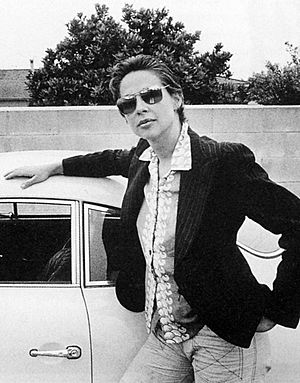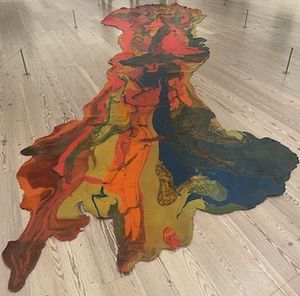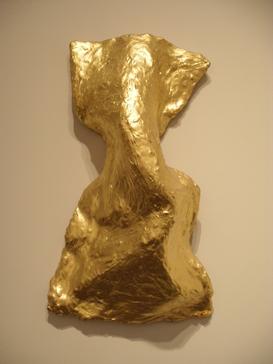Lynda Benglis facts for kids
Quick facts for kids
Lynda Benglis
|
|
|---|---|

Benglis in a 1974 photograph
|
|
| Born | October 25, 1941 |
| Known for | Sculptor, painter |
| Partner(s) | Anand Sarabhai |
Lynda Benglis (born October 25, 1941) is an American sculptor and visual artist. She is famous for her colorful paintings made with wax and her unique sculptures made from poured latex and foam. She has lived and worked in many places, including New York City, Santa Fe, New Mexico, Kastellorizo, Greece, and Ahmedabad, India.
Contents
Early Life and Education
Lynda Benglis was born in Lake Charles, Louisiana, on October 25, 1941. She is of Greek-American heritage. When she was young, she often traveled to Greece with her grandmother. She said these trips were very important for her art. Benglis saw her grandmother as a strong and independent woman who set an example for her.
Her father, Michael, owned a business that sold building materials. Her mother was from Mississippi. Lynda was the oldest of five children.
Benglis went to McNeese State University in her hometown. In 1964, she earned a Bachelor of Fine Arts degree from Newcomb College in New Orleans. There, she studied painting and how to make art with clay (ceramics). After graduating, she taught third grade for a short time.
Later in 1964, Benglis moved to New York City. This was a big step for her career. She met many famous artists like Andy Warhol, Donald Judd, and Eva Hesse. She continued her studies at the Brooklyn Museum Art School. For a while, she worked at art galleries, which helped her learn more about the art world.
Artistic Career
Benglis became known for creating art that looked like it was flowing or melting. Her work often uses shapes found in nature. She was inspired by artists like Barnett Newman and Andy Warhol, but she developed her own unique style.
New Ways of Making Art
In the late 1960s, Benglis started using unusual materials. She made paintings with layers of colorful beeswax. She also became famous for her "pours." She would pour liquid latex or a type of foam called polyurethane directly onto the floor. The liquid would spread out and harden into a sculpture.

Her artwork was very different from the simple, geometric art that was popular at the time. For example, her piece Fallen Painting (1968) was made by pouring bright, glowing paint on the gallery floor. It looked like a painting that had spilled and created its own shape. With Contraband (1969), she poured many colors of latex to create a vibrant, flowing sculpture on the ground. These pieces challenged the idea that art had to be on a canvas or a stand.

In the 1970s, Benglis also began making videos as part of her art. In the 1980s, she started working with metals like gold leaf, zinc, and aluminum. She created large, shiny sculptures, including a series of public fountains.
Throughout her career, Benglis has also been a teacher. She has taught art at several universities, including the University of Rochester and Princeton University.
Major Exhibitions
For a long time, Benglis's work was not as well-known as it is today. But in 2009, a major exhibition of her art helped people see how important she is. This show, which traveled to several museums, focused on her early work from the 1960s and 1970s.
Key Shows and Retrospectives
- 2009 Retrospective: Organized by the Irish Museum of Modern Art, this show celebrated 40 years of her work. It included her wax paintings, poured sculptures, and knotted wall pieces from the 1970s. It showed her love for experimenting with different materials and ideas.
- 2011 New Museum Show: The New Museum in New York held a large exhibition of her sculptures, videos, and photos. Critics praised the show for its energy and creativity.
- 2015 Hepworth Wakefield: This was her first major museum show in the United Kingdom. It featured over 50 artworks and explored how the different places she lived influenced her art.
- 2015 Storm King Art Center: This exhibition focused on her outdoor water fountains, showing her interest in water and nature.
- 2016 Cheim & Read Gallery: Benglis showed new sculptures made from handmade paper wrapped around wire frames. These works were inspired by the landscape of Santa Fe, New Mexico.
- 2022 Nasher Sculpture Center: An exhibition in Dallas, Texas, highlighted her more recent work, including pieces made with bronze and glitter.
Recognition and Awards
Lynda Benglis has received many awards for her contributions to art.
- In 1972, her picture was included in a famous artwork called Some Living American Women Artists / Last Supper by Mary Beth Edelson. This piece celebrated the achievements of women in the art world.
- In 1975, she received a Guggenheim Fellowship, a very important award for artists.
- She has also received grants from the National Endowment for the Arts.
- In 2017, the International Sculpture Center gave her a Lifetime Achievement Award for her amazing work in sculpture.
Her art is now in the collections of major museums all over the world. These include the Museum of Modern Art and the Whitney Museum of American Art in New York, the Los Angeles County Museum of Art, and the National Gallery of Victoria in Australia.
See also
 In Spanish: Lynda Benglis para niños
In Spanish: Lynda Benglis para niños

